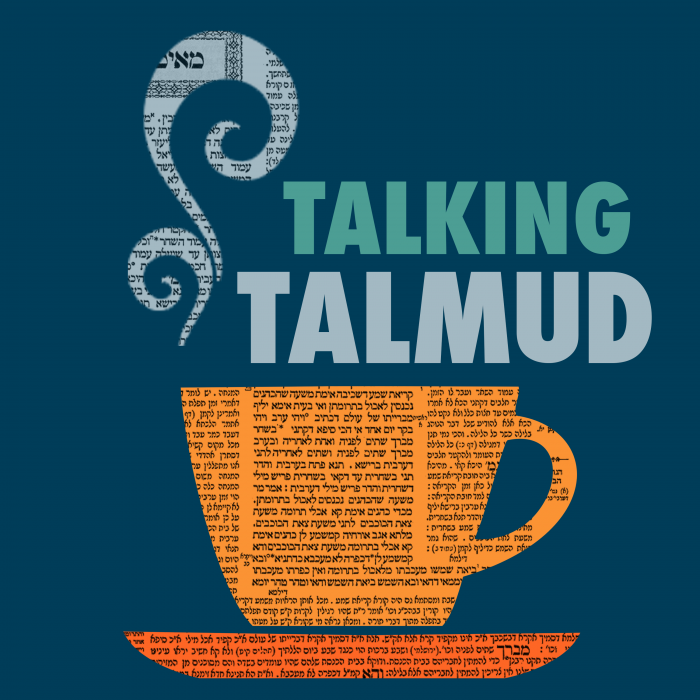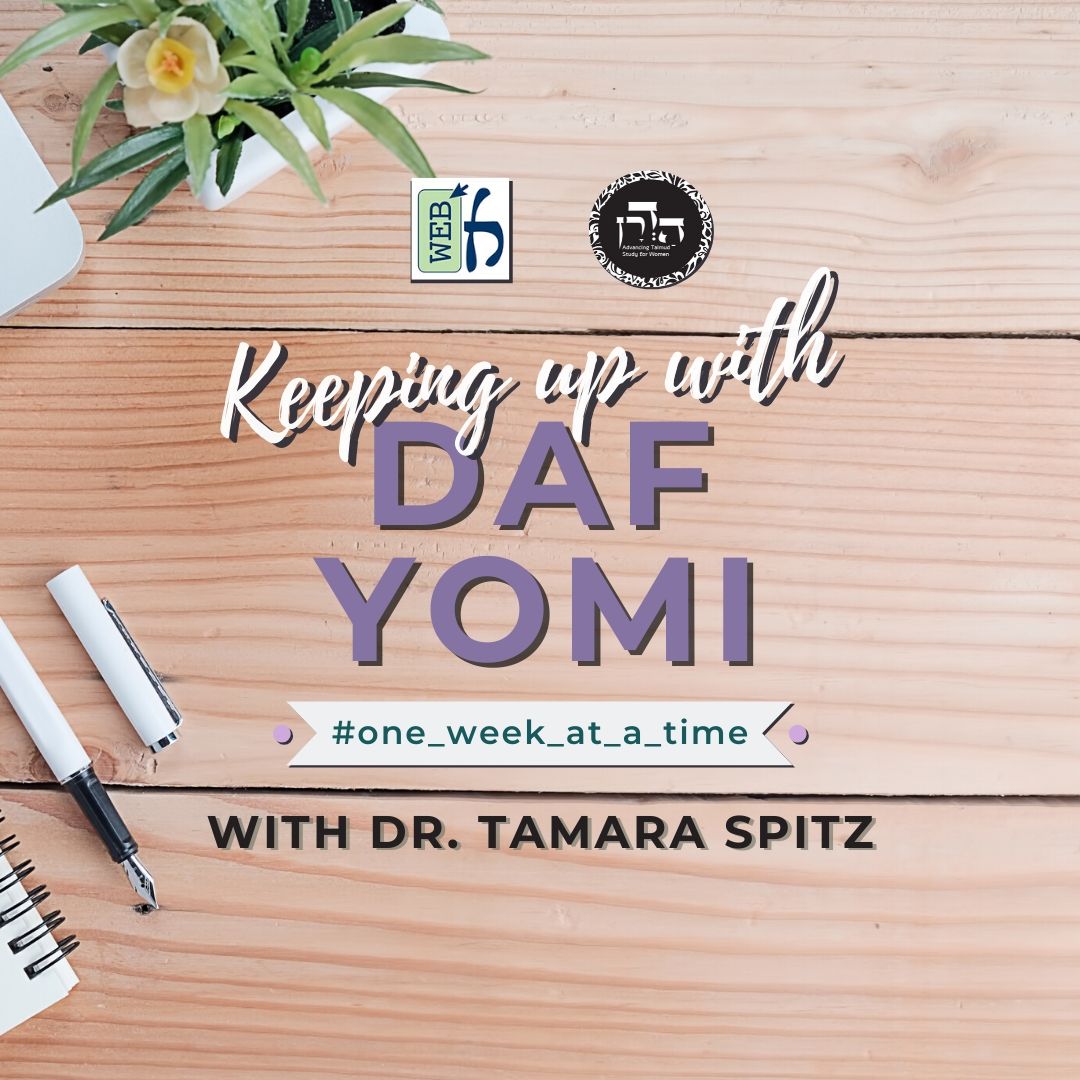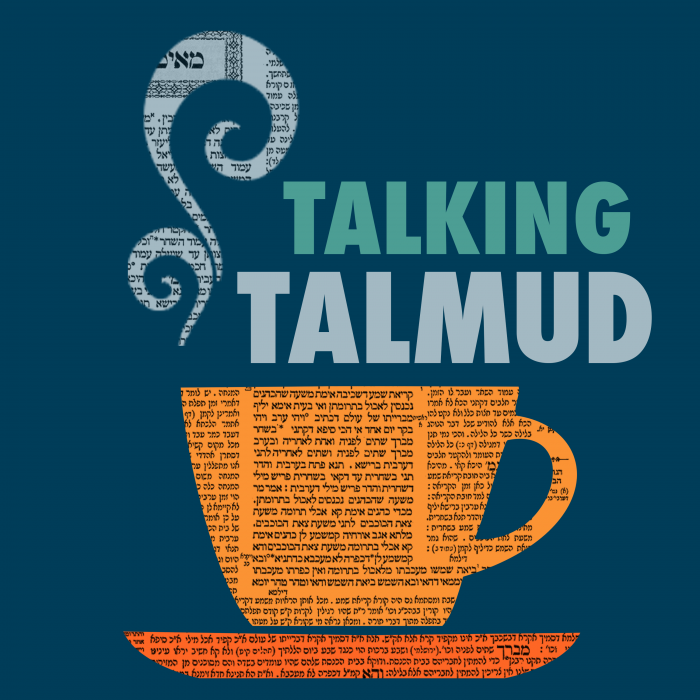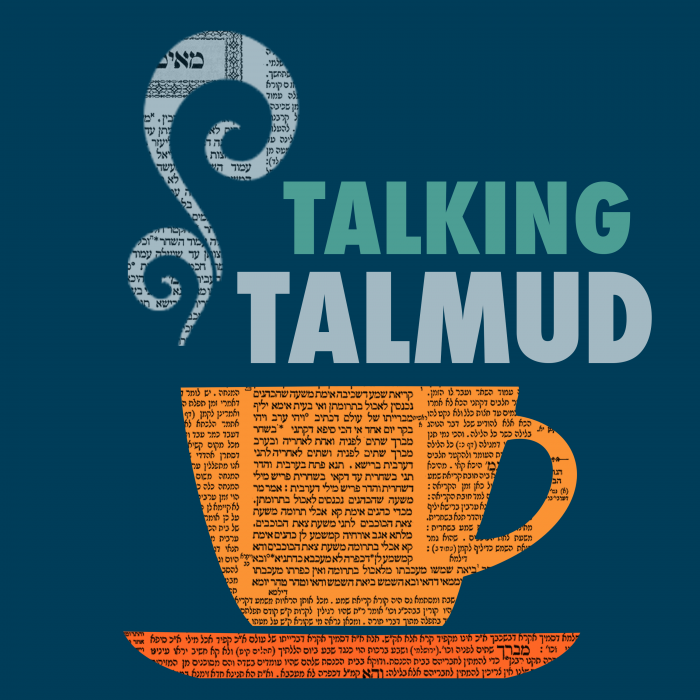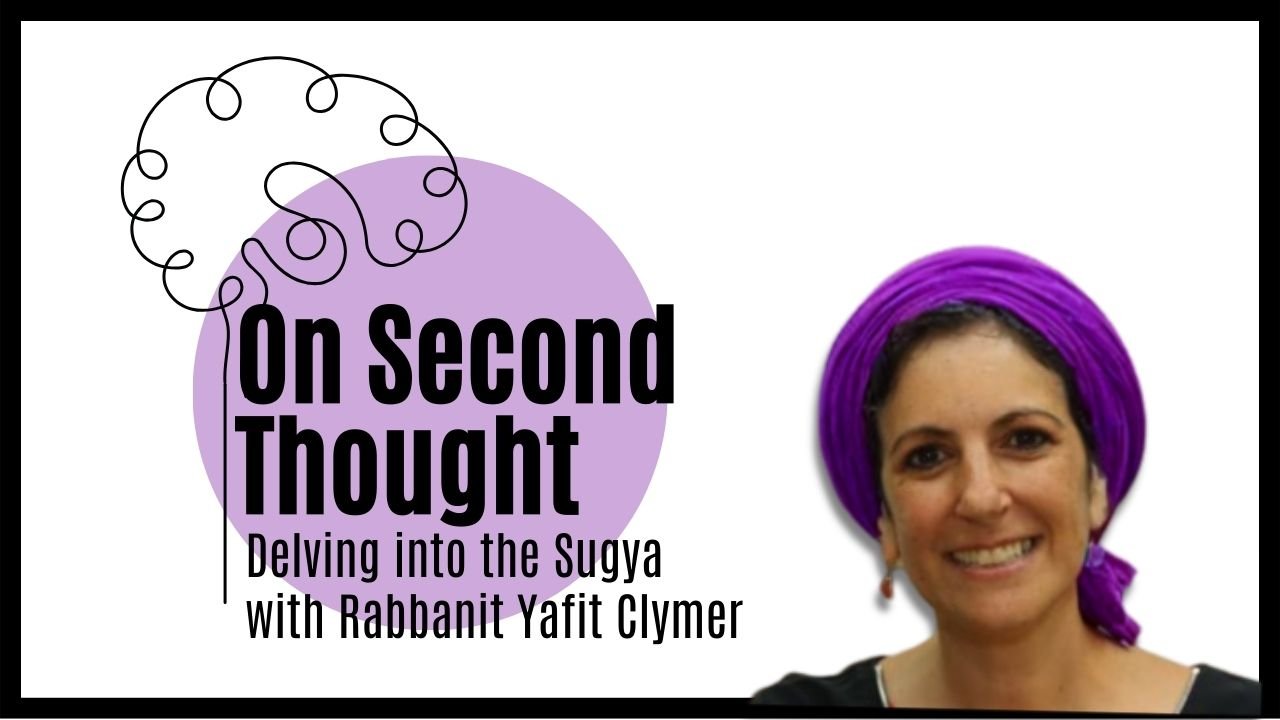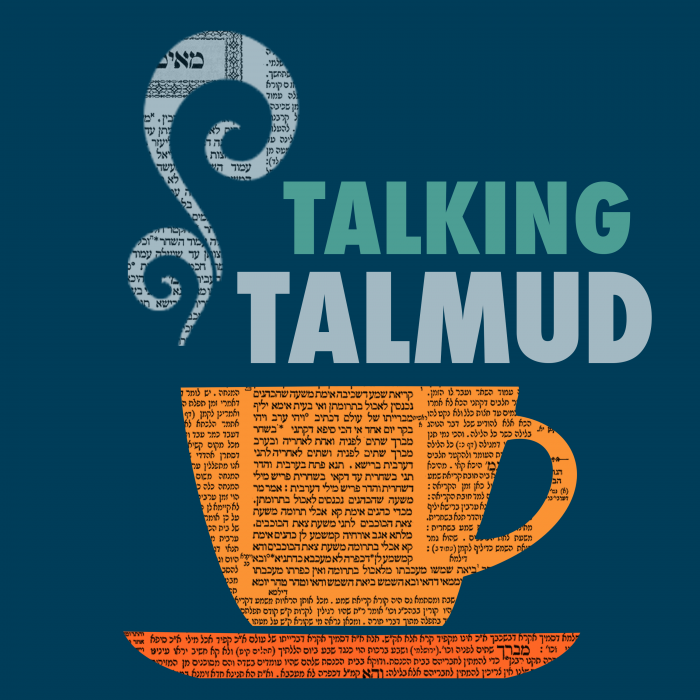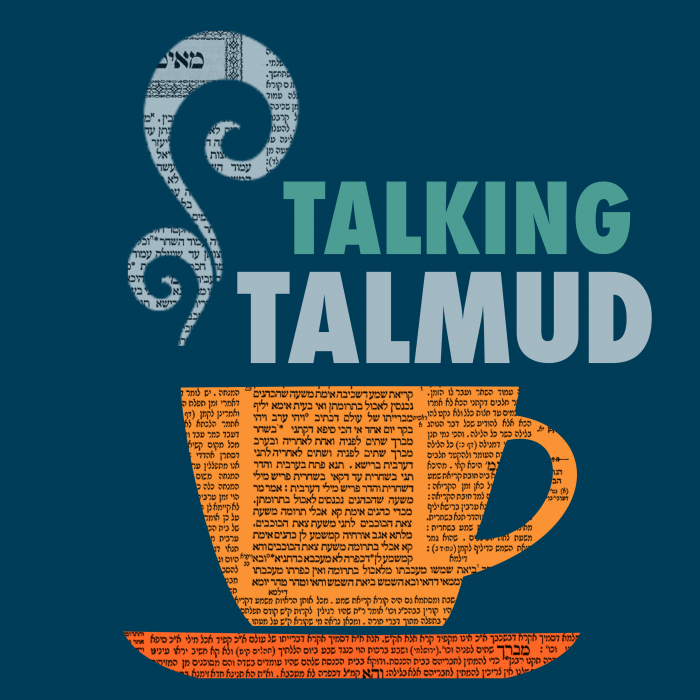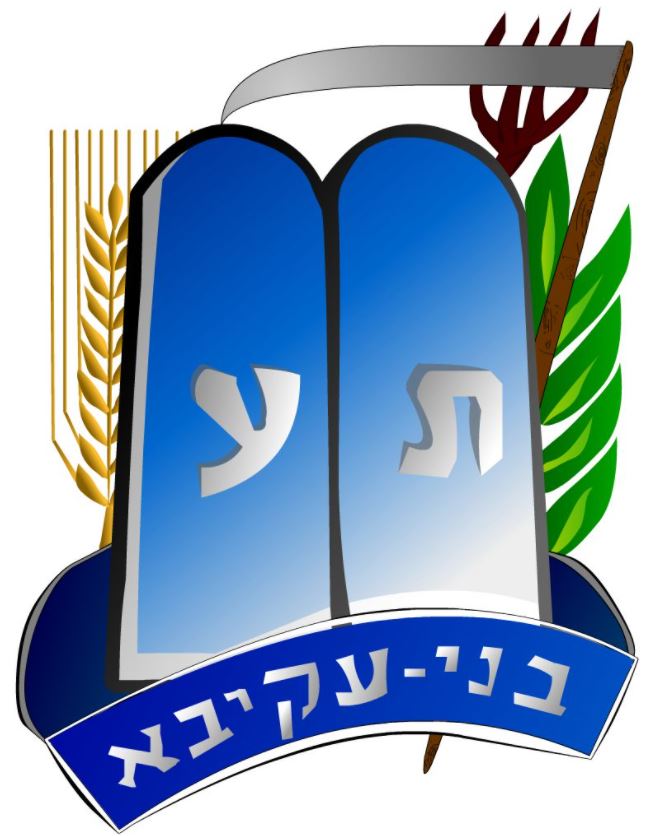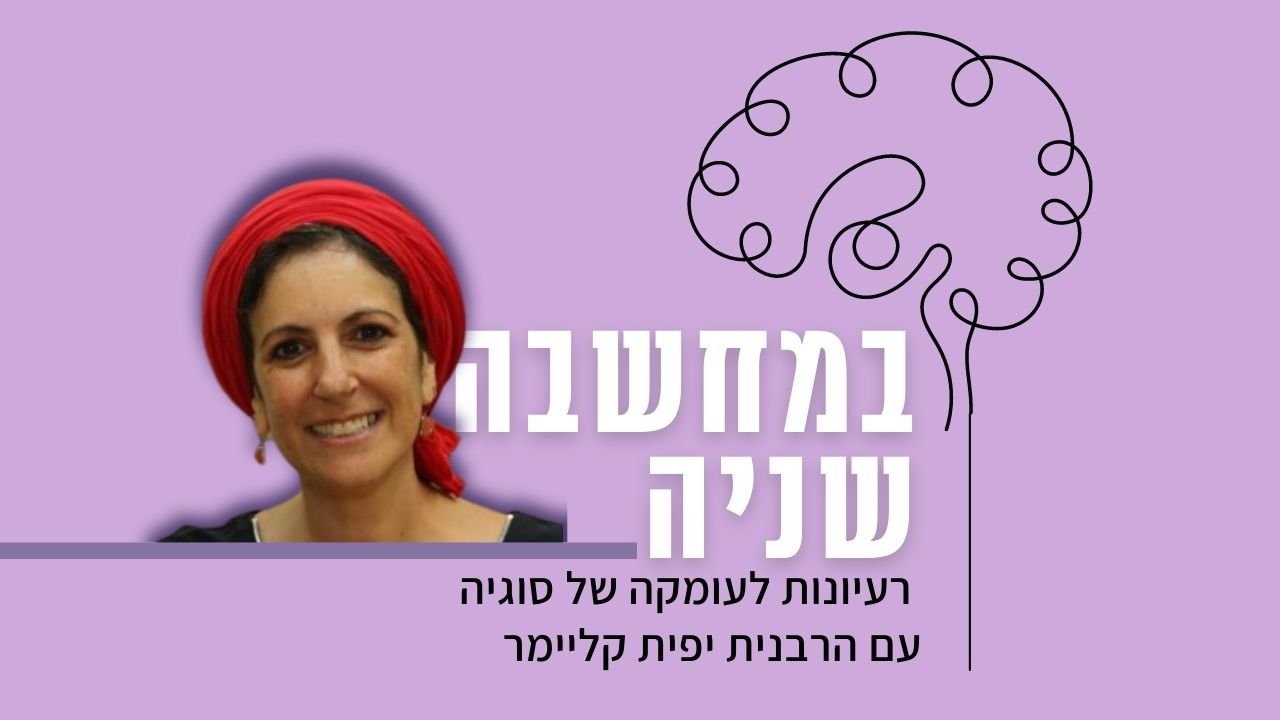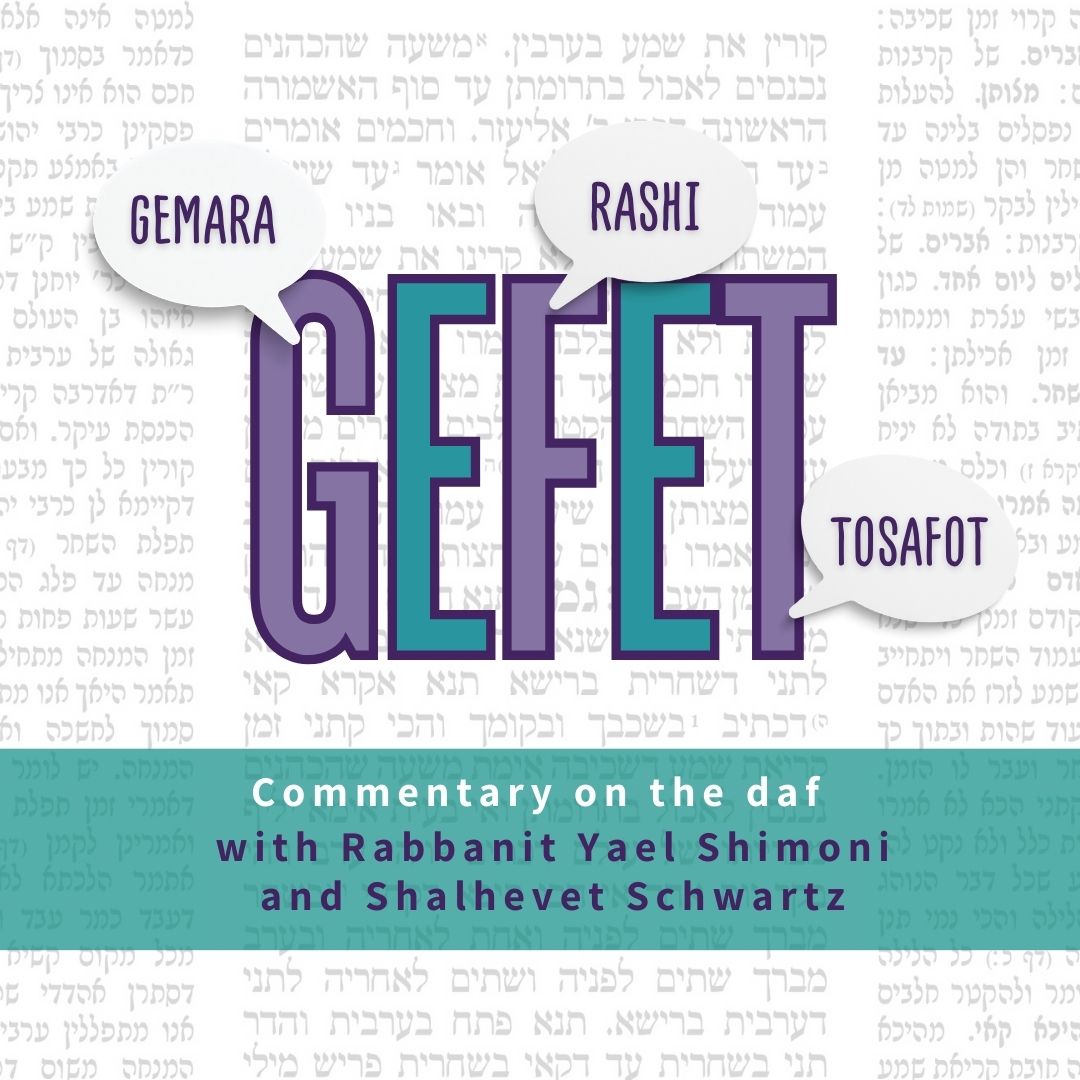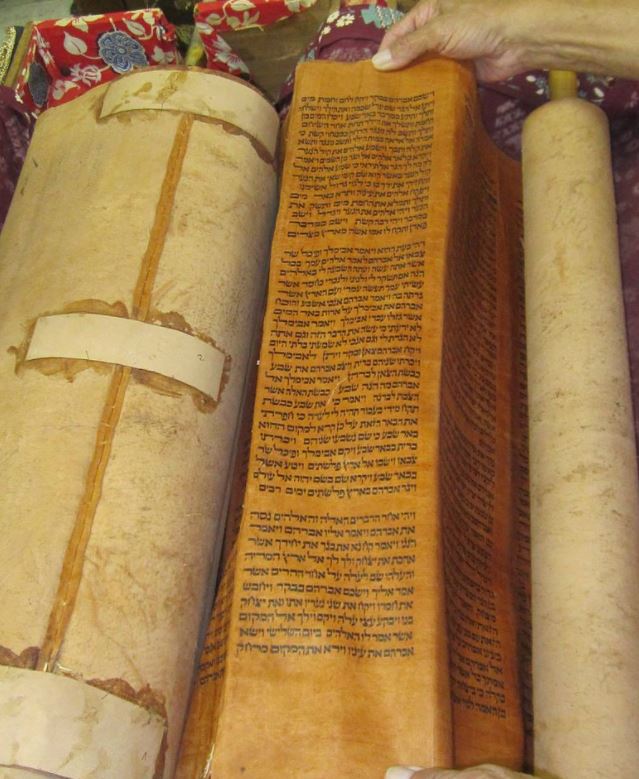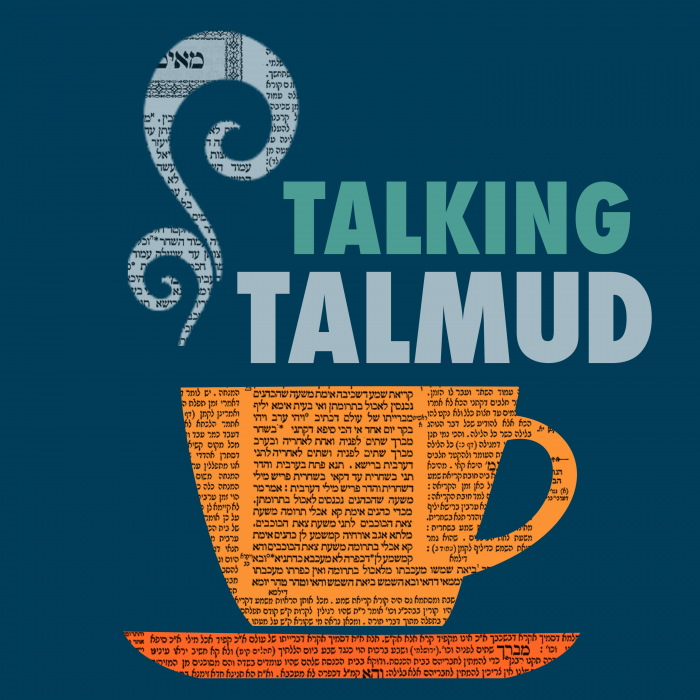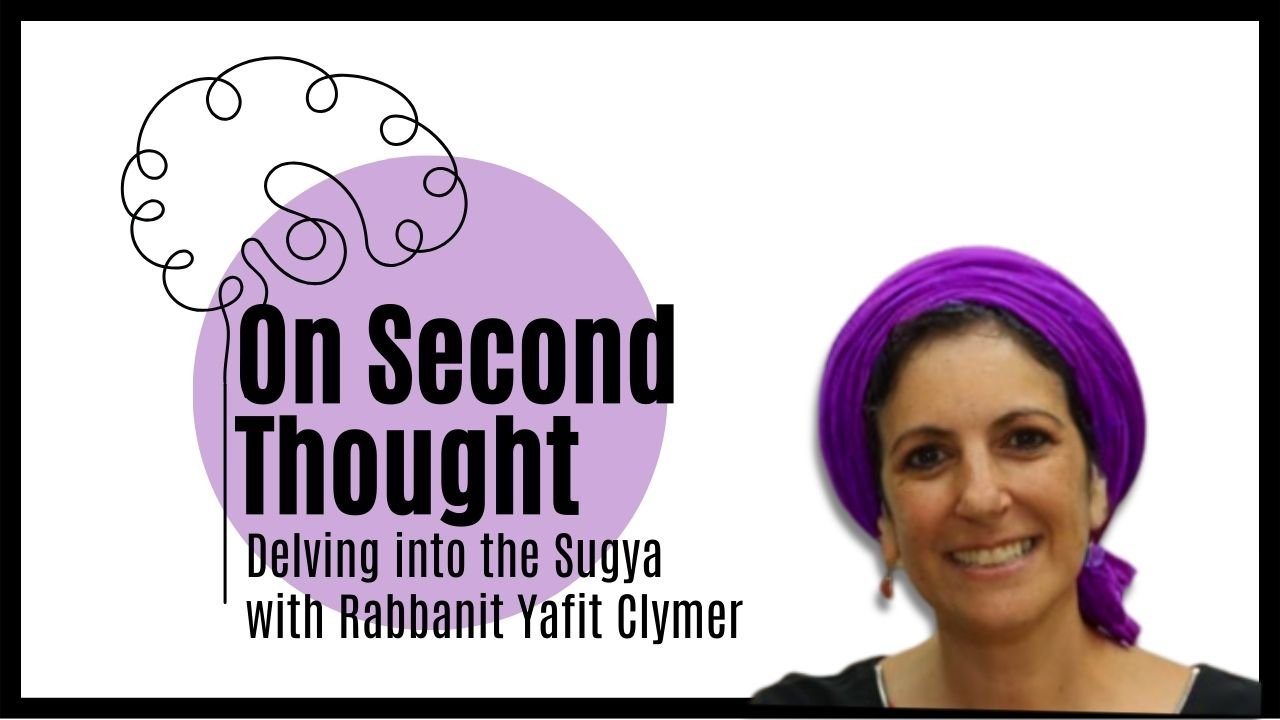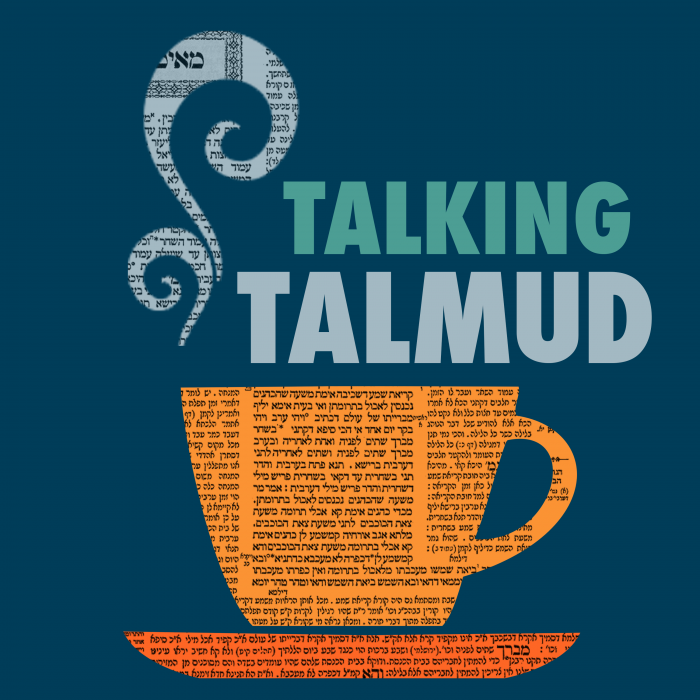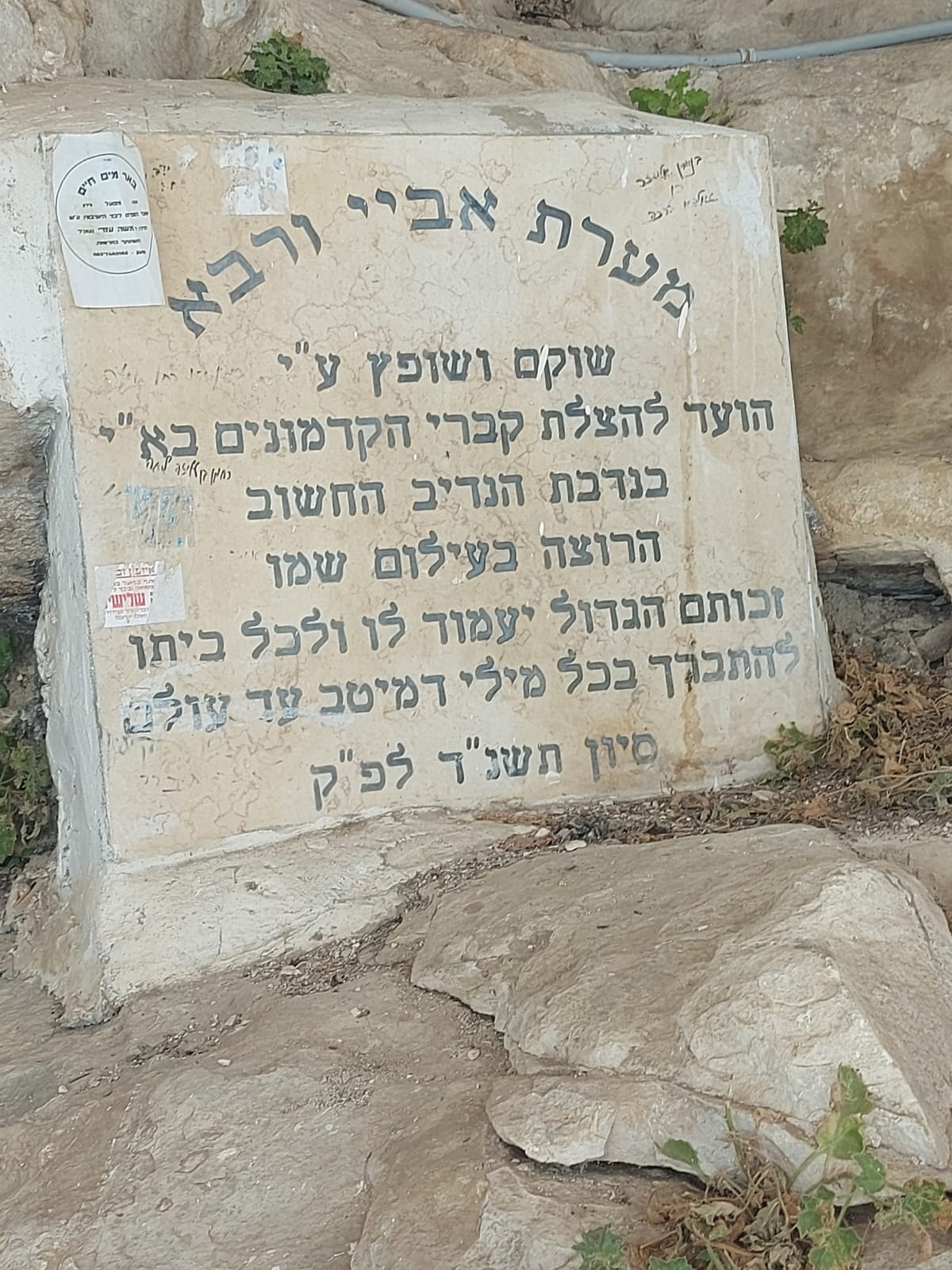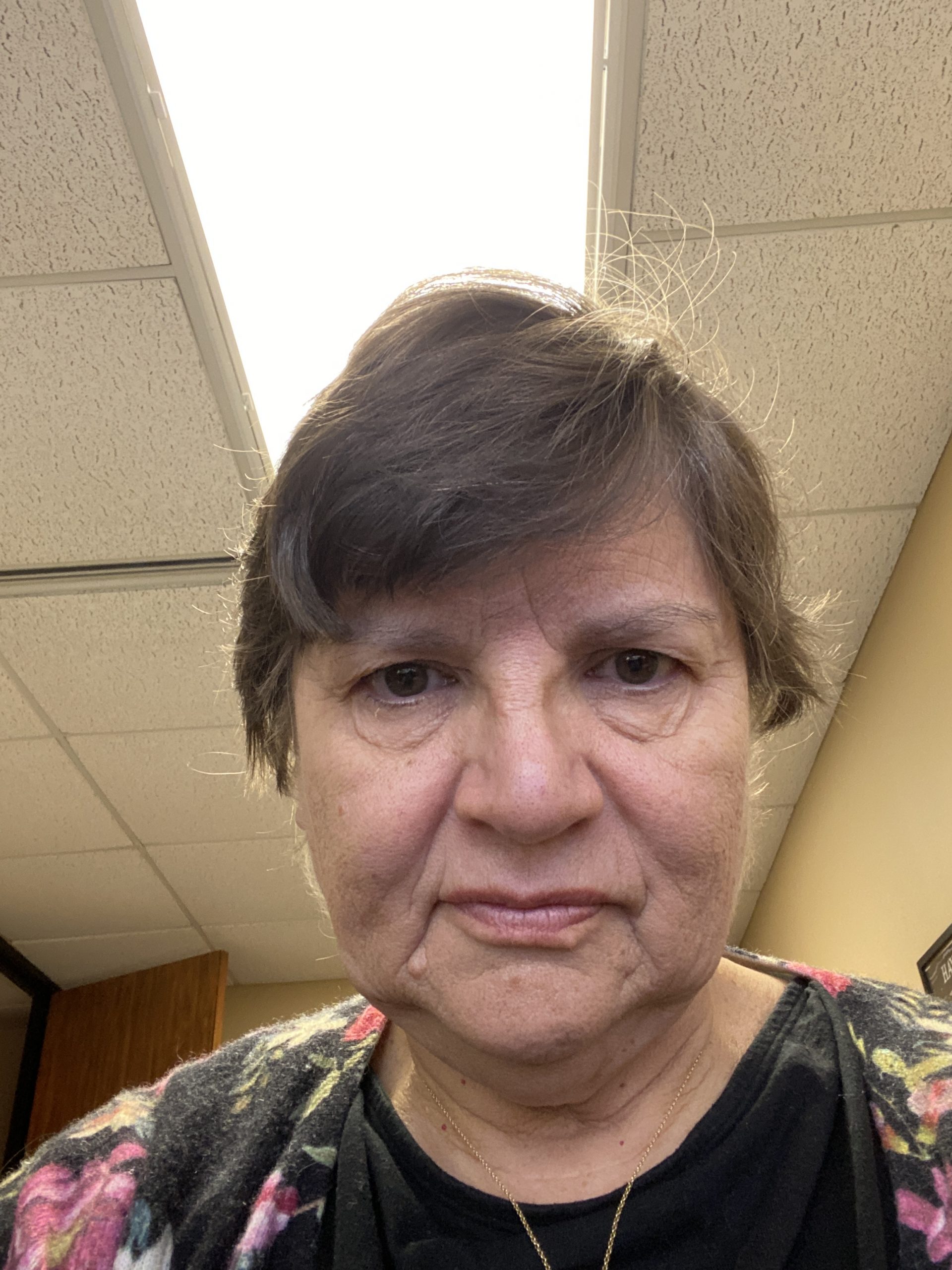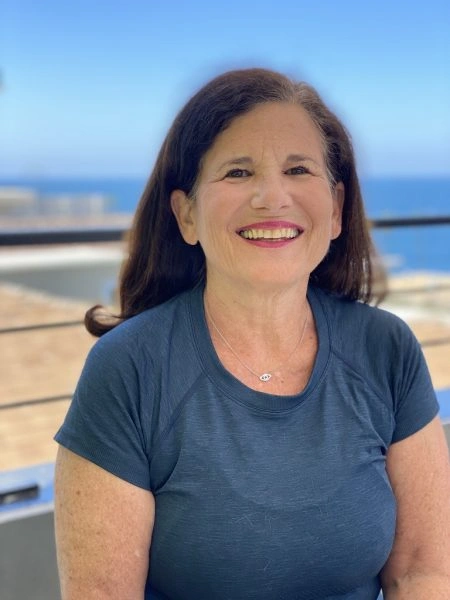Which sacrifices need the owner to perform smicha? Who is obligated in smicha? What are the laws regarding an heir whose father was obligated to bring a sacrifice? How and where is smicha performed?
This week’s learning is sponsored by Robert and Paula Cohen in loving memory of Joseph Cohen, Yosef ben Moshe HaCohen, z”l. “He was hard working, loved to sing, esp. as a chazan, and was very dedicated to his family and community.”
Want to dedicate learning? Get started here:


Today’s daily daf tools:
This week’s learning is sponsored by Robert and Paula Cohen in loving memory of Joseph Cohen, Yosef ben Moshe HaCohen, z”l. “He was hard working, loved to sing, esp. as a chazan, and was very dedicated to his family and community.”
Today’s daily daf tools:
Delve Deeper
Broaden your understanding of the topics on this daf with classes and podcasts from top women Talmud scholars.
New to Talmud?
Check out our resources designed to help you navigate a page of Talmud – and study at the pace, level and style that fits you.
The Hadran Women’s Tapestry
Meet the diverse women learning Gemara at Hadran and hear their stories.
Menachot 93
קְרָאֵי לְמָה לִי? ״קׇרְבָּנוֹ״ – וְלֹא קׇרְבַּן חֲבֵירוֹ, ״קׇרְבָּנוֹ״ – וְלֹא קׇרְבַּן גּוֹי, ״קׇרְבָּנוֹ״ – לְרַבּוֹת כׇּל בַּעֲלֵי קׇרְבָּן לִסְמִיכָה.
if the repeated term “his offering” is not needed to counter the a fortiori inferences, why do I need these three verses? The Gemara explains: One instance of “his offering” teaches that one places hands only on one’s own offering, but not on an offering of another person. Another instance of “his offering” teaches that one places hands only on one’s own offering, but not on an offering of a gentile. The third instance of “his offering” serves to include all the owners of a jointly owned offering in the requirement of placing hands, i.e., they are all required to place their hands on the offering.
הַיּוֹרֵשׁ סוֹמֵךְ.
§ The mishna states: If the owner of an offering died, then the heir is regarded as the offering’s owner. Therefore, he places his hands on the offering and brings the accompanying libations, and he can substitute a non-sacred animal for it. Although it is prohibited to perform an act of substitution, if the owner of an offering does this, his attempt is successful to the extent that the non-sacred animal is thereby consecrated, even though the original offering also remains sacred.
תָּנֵי רַב חֲנַנְיָה קַמֵּיהּ דְּרָבָא: יוֹרֵשׁ אֵינוֹ סוֹמֵךְ, יוֹרֵשׁ אֵינוֹ מֵימֵר. וְהָא אֲנַן תְּנַן: הַיּוֹרֵשׁ סוֹמֵךְ, וּמֵבִיא אֶת נְסָכָיו, וּמֵימֵר.
Rav Ḥananya taught a baraita in the presence of Rava: An heir does not place hands on an offering he inherited, and an heir cannot substitute a non-sacred animal for an offering he inherited. Rava asked: But didn’t we learn in the mishna: The heir places his hands on the offering, and brings the accompanying libations, and he can substitute a non-sacred animal for it and thereby consecrate the non-sacred animal?
אֲמַר לֵיהּ אֶיפְכַאּי? אֲמַר לֵיהּ: לָא, מַתְנִיתִין מַנִּי? רַבִּי יְהוּדָה הִיא, דְּתַנְיָא: יוֹרֵשׁ סוֹמֵךְ, יוֹרֵשׁ מֵימֵר. רַבִּי יְהוּדָה אוֹמֵר: יוֹרֵשׁ אֵינוֹ סוֹמֵךְ, יוֹרֵשׁ אֵינוֹ מֵימֵר.
Rav Ḥananya said to Rava: Should I reverse the current version of the baraita to have it be in accordance with the mishna? Rava said to him: No, as whose opinion is expressed in the mishna? It is the opinion of Rabbi Yehuda, as it is taught in a baraita: An heir places hands, and an heir can effect substitution. Rabbi Yehuda says: An heir does not place hands, and an heir cannot effect substitution.
מַאי טַעְמָא דְּרַבִּי יְהוּדָה? ״קׇרְבָּנוֹ״ – וְלֹא קׇרְבַּן אָבִיו, וְיָלֵיף תְּחִלַּת הֶקְדֵּשׁ מִסּוֹף הֶקְדֵּשׁ: מָה סוֹף הֶקְדֵּשׁ – יוֹרֵשׁ אֵינוֹ סוֹמֵךְ, אַף תְּחִילַּת הֶקְדֵּשׁ – יוֹרֵשׁ אֵינוֹ מֵימֵר.
The Gemara clarifies: What is the reasoning of Rabbi Yehuda? He expounds the term “his offering” as teaching that one places hands only on one’s own offering, but not on one’s father’s offering that one inherited. And furthermore, Rabbi Yehuda derives the halakha concerning who can substitute a non-sacred animal for an offering, which is the initial stage of consecration, from the halakha concerning who performs the rite of placing hands on the offering, which is the final stage of consecration: Just as with regard to the final stage of consecration, an heir does not place his hands, so too, with regard to the initial stage of consecration, an heir cannot effect substitution.
וְרַבָּנַן: ״הָמֵר יָמִיר״ – לְרַבּוֹת אֶת הַיּוֹרֵשׁ, וְיָלֵיף סוֹף הֶקְדֵּשׁ מִתְּחִילַּת הֶקְדֵּשׁ: מָה תְּחִלַּת הֶקְדֵּשׁ – יוֹרֵשׁ מֵימֵר, אַף סוֹף הֶקְדֵּשׁ – יוֹרֵשׁ סוֹמֵךְ.
And as for the Rabbis, from where do they derive their opinion? The verse states: “If he shall substitute [hamer yamir] animal for animal” (Leviticus 27:10), with the doubled form of hamer yamir serving to include the heir as one capable of effecting substitution. And furthermore, they derive the halakha concerning who performs the rite of placing hands, which is the final stage of consecration, from the halakha concerning who can effect substitution, which is an initial stage of consecration: Just as with regard to the initial stage of consecration, an heir can effect substitution, so too, with regard to the final stage of consecration, an heir places his hands.
וְרַבָּנַן, הַאי ״קׇרְבָּנוֹ״ מַאי עָבְדִי לֵיהּ? ״קׇרְבָּנוֹ״ – וְלֹא קׇרְבַּן גּוֹי, ״קׇרְבָּנוֹ״ – וְלֹא קׇרְבַּן חֲבֵירוֹ, ״קׇרְבָּנוֹ״ – לְרַבּוֹת כׇּל בַּעֲלֵי קׇרְבָּן לִסְמִיכָה.
The Gemara asks: And as for the Rabbis, what do they do with this term: “His offering”? The Gemara explains how the Rabbis expound each mention of the term. One instance of “his offering” teaches that one places hands only on one’s own offering, but not on an offering of a gentile. Another instance of “his offering” teaches that one places hands only on one’s own offering, but not on an offering of another person. The third instance of “his offering” serves to include all the owners of a jointly owned offering in the requirement of placing hands, i.e., they are all required to place their hands on the offering.
וְרַבִּי יְהוּדָה, לְרַבּוֹת כׇּל בַּעֲלֵי קׇרְבָּן לִסְמִיכָה – לֵית לֵיהּ, וְאִי נָמֵי אִית לֵיהּ – גּוֹי וַחֲבֵירוֹ מֵחַד קְרָא נָפְקָא. אִיַּיתַּרוּ לֵיהּ תְּרֵי קְרָאֵי: חַד – ״קׇרְבָּנוֹ״ וְלֹא קׇרְבַּן אָבִיו, וְאִידַּךְ – לְרַבּוֹת כׇּל בַּעֲלֵי קׇרְבָּן לִסְמִיכָה.
The Gemara clarifies: And Rabbi Yehuda does not hold that one of the mentions serves to include all the owners of a jointly owned offering in the requirement of placing hands, so he is able to expound it to exclude an heir from the requirement. Alternatively, if he holds that one of the mentions serves to include owners of a jointly owned offering, then he must derive that one does not place hands on the offering of a gentile or of another person from the same one mention in the verse, which leaves him two more mentions in the verses. One he expounds to teach that on “his offering” he places hands, but not on his father’s offering that he inherited, and the other mention remains to include all the owners of a jointly owned offering in the requirement of placing hands.
וְרַבִּי יְהוּדָה, הַאי ״הָמֵר יָמִיר״ מַאי עָבֵיד לֵיהּ? מִיבְּעֵי לֵיהּ לְרַבּוֹת אֶת הָאִשָּׁה, דְּתַנְיָא: לְפִי שֶׁכׇּל הָעִנְיָן כּוּלּוֹ אֵינוֹ מְדַבֵּר אֶלָּא בִּלְשׁוֹן זָכָר, מָה סוֹפֵינוּ לְרַבּוֹת אֶת הָאִשָּׁה? תַּלְמוּד לוֹמַר ״הָמֵר יָמִיר״.
The Gemara asks: And as for Rabbi Yehuda, what does he do with the use of the doubled form in this verse: “If he shall substitute [hamer yamir]”? The Gemara answers: He requires it to include a woman among those who can effect substitution. As it is taught in a baraita: Since the entire matter of substitution is stated in the Torah only in the masculine form, what is the reason that we ultimately come to include a woman? The verse states: “If he shall substitute [hamer yamir],” using a doubled form.
וְרַבָּנַן דָּרְשִׁי מִ״וְּאִם״, וְרַבִּי יְהוּדָה ״וְאִם״ לָא דָּרֵישׁ.
And as for the Rabbis, they derive that a woman can effect substitution from the term: “And if” (Leviticus 27:10), in the phrase “and if he shall substitute.” And Rabbi Yehuda does not expound the term “and if” at all.
מַתְנִי׳ הַכֹּל סוֹמְכִין, חוּץ מֵחֵרֵשׁ, שׁוֹטֶה, וְקָטָן, וְסוֹמֵא, וְגוֹי, וְהָעֶבֶד, וְהַשָּׁלִיחַ, וְהָאִשָּׁה.
MISHNA: Everyone who brings an animal offering places hands upon its head, except for a deaf-mute, an imbecile, a minor, a blind person, a gentile, a Canaanite slave, the agent of the owner of the offering who brings the offering on the owner’s behalf, and a woman.
וּסְמִיכָה – שְׁיָרֵי מִצְוָה.
And the requirement of placing hands is a non-essential mitzva; therefore, failure to place hands does not prevent the owner from achieving atonement.
עַל הָרֹאשׁ בִּשְׁתֵּי יָדַיִם, וּבִמְקוֹם שֶׁסּוֹמְכִין שׁוֹחֲטִין, וְתֵכֶף לִסְמִיכָה שְׁחִיטָה.
The rite of placing hands is performed by leaning on the head of the offering with two hands. And in the same location in the Temple that one places hands, one slaughters the animal. And immediately following the rite of placing hands, the slaughter is performed.
גְּמָ׳ בִּשְׁלָמָא חֵרֵשׁ שׁוֹטֶה וְקָטָן, דְּלָאו בְּנֵי דֵעָה נִינְהוּ. גּוֹי נָמֵי – ״בְּנֵי יִשְׂרָאֵל״ סוֹמְכִין וְאֵין גּוֹיִם סוֹמְכִין. אֶלָּא סוֹמֵא מַאי טַעְמָא לָא?
GEMARA: The Gemara explains why certain types of people do not place hands on an offering: Granted, a deaf-mute, an imbecile, and a minor do not place their hands on the offering, as they are not mentally competent. The exclusion of a gentile is also understandable, as the verses concerning placing hands are introduced with: “Speak to the children of Israel and say to them” (Leviticus 1:2), which indicates that the children of Israel place hands upon their offerings, but gentiles do not place their hands upon their offerings. But with regard to a blind person, what is the reason that he does not place his hands on his offering?
רַב חִסְדָּא וְרַב יִצְחָק בַּר אַבְדִּימִי, חַד אָמַר: אָתְיָא סְמִיכָה סְמִיכָה מִ״זִּקְנֵי עֵדָה״.
Rav Ḥisda and Rav Yitzḥak bar Avdimi disagree as to the source of the exclusion of a blind person. One said that it is derived from a verbal analogy between the mention of placing hands in the passage detailing the general requirement to do so, and the mention of placing hands stated with regard to the bull offering brought for a community-wide violation perpetrated due to an erroneous ruling of the Sanhedrin, which is performed by the Elders of the congregation, i.e., the judges of the Sanhedrin: Just as the judges may not be blind (see Sanhedrin 34b), so too the rite of placing hands is not performed by a blind person.
וְחַד אָמַר: אָתְיָא סְמִיכָה סְמִיכָה מֵעוֹלַת רְאִיָּיה.
And the other one said that it is derived from a verbal analogy between the mention of placing hands in the passage detailing the general requirement to do so, and the mention of placing hands stated with regard to the burnt offering of appearance brought by an individual on the pilgrimage Festivals: Just as a blind person is exempt from making the pilgrimage to Jerusalem and bringing the offering (see Ḥagiga 2a), so too he is excluding from the requirement of placing hands.
וּלְמַאן דְּאָמַר מֵעוֹלַת רְאִיָּיה, מַאי טַעְמָא לָא יָלֵיף מִן זִקְנֵי עֵדָה?
The Gemara asks: And according to the one who said that the exclusion of a blind person is derived from the burnt offering of appearance, what is the reason that he does not derive this from the placing of hands performed by the Elders of the congregation?
דָּנִין יָחִיד מִיָּחִיד, וְאֵין דָּנִין יָחִיד מִצִּיבּוּר.
The Gemara answers: He holds that one derives the halakhot of the offering of an individual from the halakhot of another offering of an individual, such as the burnt offering of appearance, and one does not derive the halakhot of the offering of an individual from the halakhot of a communal offering, e.g., the bull brought for a community-wide violation.
וּלְמַאן דְּיָלֵיף מִזִּקְנֵי עֵדָה, מַאי טַעְמָא לָא יָלֵיף מֵעוֹלַת רְאִיָּיה? דָּנִין מִידֵּי דִּכְתִיב בֵּיהּ סְמִיכָה בְּגוּפֵיהּ, מִמִּידֵּי דִּכְתִיב בֵּיהּ סְמִיכָה בְּגוּפֵיהּ, לְאַפּוֹקֵי עוֹלַת רְאִיָּיה, דְּהִיא גּוּפַהּ מֵעוֹלַת נְדָבָה גָּמְרָה.
The Gemara asks: And according to the one who said that the exclusion of a blind person is derived from the placing of hands performed by the Elders of the congregation, what is the reason that he does not derive this from the burnt offering of appearance? The Gemara answers: He holds that one derives the halakhot of a matter concerning which the requirement of placing hands is explicitly written with regard to that case itself, as is the case in the passage detailing the general requirement of placing hands, from another matter concerning which placing hands is also explicitly written with regard to that case itself, as is the case in the passage describing the bull brought for a community-wide violation of a sin. This serves to exclude the possibility of deriving the halakhot from those of the burnt offering of appearance, as the requirement to place hands upon it is not explicitly written in the Torah with regard to it, but rather it itself is derived from the requirement stated with regard to a voluntary burnt offering.
דְּתָנֵי תַּנָּא קַמֵּיהּ דְּרַב יִצְחָק בַּר אַבָּא: ״וַיַּקְרֵב אֶת הָעֹלָה וַיַּעֲשֶׂהָ כַּמִּשְׁפָּט״ – כְּמִשְׁפַּט עוֹלַת נְדָבָה, לִימֵּד עַל עוֹלַת חוֹבָה שֶׁטְּעוּנָה סְמִיכָה.
This is as a tanna taught in a baraita in the presence of Rav Yitzḥak bar Abba: With regard to the obligatory offering brought by Aaron the High Priest on the eighth day of the inauguration of the Tabernacle, it is written: “And the burnt offering was presented, and he sacrificed in accordance with the ordinance” (Leviticus 9:16). This last phrase means: In accordance with the ordinance of a voluntary burnt offering. Accordingly, this verse teaches about every obligatory burnt offering, including the burnt offering of appearance, that it requires placing hands, just as a voluntary burnt offering does.
וְהָעֶבֶד וְהַשָּׁלִיחַ וְהָאִשָּׁה. תָּנוּ רַבָּנַן: ״יָדוֹ״ – וְלֹא יַד עַבְדּוֹ, ״יָדוֹ״ – וְלֹא יַד שְׁלוּחוֹ, ״יָדוֹ״ – וְלֹא יַד אִשְׁתּוֹ.
§ The mishna states: A Canaanite slave, the agent of the owner of the offering who brings the offering on his behalf, and a woman do not place hands on their offerings. Concerning these halakhot, the Sages taught in a baraita: The term “his hand” is mentioned three times in Leviticus, chapter 3, which details the requirement of placing hands. Each mention is expounded to exclude a different case. “His hand” (Leviticus 3:2), but not the hand of his Canaanite slave; “his hand” (Leviticus 3:8), but not the hand of his agent; “his hand” (Leviticus 3:13), but not the hand of his wife.
כֹּל הָנֵי לְמָה לִי? צְרִיכָא, אִי כְּתַב רַחֲמָנָא חַד, הֲוָה אָמֵינָא לְמַעוֹטֵי עֶבֶד, דְּלָאו בַּר מִצְוֹת, אֲבָל שָׁלִיחַ דְּבַר מִצְוָה הוּא, וּשְׁלוּחוֹ שֶׁל אָדָם כְּמוֹתוֹ, אֵימָא לִסְמוֹךְ.
The Gemara asks: Why do I need all these three exclusions? The Gemara explains that all three mentions are necessary, as had the Merciful One written only one exclusion, I would say that it serves to exclude only a Canaanite slave, as since he is not commanded in mitzvot it is reasonable that he cannot perform the rite of placing hands. But with regard to an agent, since he is commanded in mitzvot, and there is a principle that the halakhic status of a person’s agent is like that of himself, one might say that he could place his hands on the offering of the owner on the owner’s behalf, and thereby fulfill the requirement. Therefore, it is necessary to have an independent source to exclude an agent.
וְאִי אַשְׁמְעִינַן הָנֵי תַּרְתֵּי, דְּלָאו כְּגוּפֵיהּ דָּמְיָא, אֲבָל אִשְׁתּוֹ דִּכְגוּפֵיהּ דָּמְיָא, אֵימָא תִּיסְמֹךְ – צְרִיכָא.
And had the Merciful One taught us only these two halakhot, one would have excluded only a Canaanite slave and an agent, as they are not considered like his own flesh. But with regard to his wife, who is considered like his own flesh, one might say that she places her hands on her husband’s offering. Therefore, the third mention is necessary to teach that even a wife cannot fulfill the requirement on behalf of her husband.
סְמִיכָה שְׁיָרֵי מִצְוָה. תָּנוּ רַבָּנַן: ״וְסָמַךְ״ ״וְנִרְצָה״, וְכִי סְמִיכָה מְכַפֶּרֶת? וַהֲלֹא אֵין כַּפָּרָה אֶלָּא בַּדָּם, שֶׁנֶּאֱמַר: ״כִּי הַדָּם הוּא בַּנֶּפֶשׁ יְכַפֵּר״! אֶלָּא לוֹמַר לָךְ, שֶׁאִם עֲשָׂאָהּ לִסְמִיכָה שְׁיָרֵי מִצְוָה, מַעֲלֶה עָלָיו הַכָּתוּב כְּאִילּוּ לֹא כִּיפֵּר, וְכִיפֵּר.
§ The mishna states: The requirement of placing hands is a non-essential mitzva. The Sages taught in a baraita: “And he shall place his hand upon the head of the burnt offering, and it shall be accepted for him to effect atonement for him” (Leviticus 1:4). The baraita asks: But does the rite of placing hands effect atonement? Isn’t atonement effected only through the presentation of the blood? As it is stated with regard to blood: “For the soul of the flesh is in the blood, and I have given it to you upon the altar to effect atonement for your souls, for it is the blood of the soul that effects atonement” (Leviticus 17:11). Rather, the verse serves to say to you that if one treated placing hands as though it were a non-essential mitzva and therefore neglected to perform it, then the verse ascribes him blame as though he did not effect atonement; but nevertheless, in actuality, the offering atones for his sin and he does not need to bring another offering.
וְתַנְיָא גַּבֵּי תְנוּפָה כִּי הַאי גַוְונָא: ״לִתְנוּפָה לְכַפֵּר״, וְכִי תְּנוּפָה מְכַפֶּרֶת? וַהֲלֹא אֵין כַּפָּרָה אֶלָּא בַּדָּם, שֶׁנֶּאֱמַר: ״כִּי הַדָּם הוּא בַּנֶּפֶשׁ יְכַפֵּר״! אֶלָּא לוֹמַר לָךְ, שֶׁאִם עֲשָׂאָהּ לִתְנוּפָה שְׁיָרֵי מִצְוָה, מַעֲלֶה עָלָיו הַכָּתוּב כְּאִילּוּ לֹא כִּיפֵּר, וְכִיפֵּר.
And it is taught in a baraita with regard to waving in this way: “He shall take one male lamb as a guilt offering to be waved to effect atonement for him” (Leviticus 14:21). The baraita asks: Does waving the offering effect atonement? Isn’t atonement effected only through the presentation of the blood? As it is stated: “For it is the blood of the soul that effects atonement” (Leviticus 17:11). Rather, the verse serves to say to you that if one treated waving as though it were a non-essential mitzva and therefore neglected to perform it, then the verse ascribes him blame as though he did not effect atonement; but nevertheless, in actuality, the offering effects atonement for his sin and he does not need to bring another offering.
עַל הָרֹאשׁ, תָּנוּ רַבָּנַן: ״יָדוֹ עַל הָרֹאשׁ״ – וְלֹא יָדוֹ עַל הַצַּוָּאר, ״יָדוֹ עַל הָרֹאשׁ״ – וְלֹא יָדוֹ עַל הַגַּבַּיִים, ״יָדוֹ עַל הָרֹאשׁ״ – וְלֹא יָדוֹ עַל הֶחָזֶה.
§ The mishna further states that that placing hands is performed by leaning on the head of the offering. The Sages taught in a baraita: The phrase “his hand upon the head” is mentioned three times in Leviticus, chapter 3. Each mention is expounded to exclude the possibility of performing the rite on a different part of the animal’s body. Placing hands is performed with “his hand upon the head” (Leviticus 3:2), but not with his hand on the neck of the animal; with “his hand upon the head” (Leviticus 3:8), but not with his hand on the back of the animal; with “his hand upon the head” (Leviticus 3:13), but not with his hand on the breast of the animal.
כֹּל הָנֵי לְמָה לִי? צְרִיכִי, דְּאִי כְּתַב רַחֲמָנָא חַד לְמַעוֹטֵי צַוָּאר, דְּלָא קָאֵי בַּהֲדֵי רֹאשׁוֹ, אֲבָל גַּבּוֹ דְּקָאֵי לַהֲדֵי רֹאשׁוֹ אֵימָא לָא, צְרִיכָא.
The Gemara asks: Why do I need all these three exclusions? The Gemara explains that all three mentions are necessary, as had the Merciful One written only one exclusion, I would say that it serves to exclude only the animal’s neck, as it is not level with the head of the animal. But with regard to its back, which is level with its head, one might say that it is not precluded and that one can fulfill the requirement by placing one’s hands there. Therefore, it is necessary to have an independent source to exclude the animal’s back.
וְאִי אַשְׁמְעִינַן הָנֵי תְּרֵי, מִשּׁוּם דְּלָא אִיתְרַבִּי לִתְנוּפָה, אֲבָל חָזֶה דְּאִיתְרַבִּי לִתְנוּפָה, אֵימָא לָא, צְרִיכָא.
And had the Torah taught us only these two halakhot, one would have excluded only the neck and the back, as those parts are not included in the waving of the offering, i.e., they are not waved. But with regard to the animal’s breast, which is included in the waving of the offering, one might say that it is not precluded and that one can fulfill the requirement by placing one’s hands there. Therefore, the third mention is necessary to teach that placing hands cannot be performed even on the animal’s breast.
אִיבַּעְיָא לְהוּ: יָדוֹ עַל הַצְּדָדִין, מַהוּ? תָּא שְׁמַע, דְּתַנְיָא: אַבָּא בִּירָאָה בְּרַבִּי אֱלִיעֶזֶר בֶּן יַעֲקֹב אוֹמֵר: ״יָדוֹ עַל רֹאשׁוֹ״, וְלָא יָדוֹ עַל הַצְּדָדִין.
A dilemma was raised before the Sages: If one placed his hand on the sides of the animal’s head, what is the halakha; does one fulfill the requirement of placing hands by doing so? The Gemara answers: Come and hear, as it is taught in a baraita: Abba Bira’a, son of Rabbi Eliezer ben Ya’akov, says that the verse: “And he shall place his hand upon the head of the burnt offering” (Leviticus 1:4), indicates that it must be done with his hand on the top of its head and not with his hand on the sides of its head.
בָּעֵי רַבִּי יִרְמְיָה: מַטְלֵית מַהוּ שֶׁתָּחוֹץ? תָּא שְׁמַע: וּבִלְבַד שֶׁלֹּא יְהֵא דָּבָר חוֹצֵץ בֵּינוֹ לְבֵין הַזֶּבַח.
Rabbi Yirmeya raises a dilemma: If one’s hands were wrapped in a cloth, what is the halakha as to whether the cloth is regarded as an interposition between his hands and the animal such that it invalidates the rite? The Gemara answers: Come and hear a resolution from a baraita, which states: The rite is valid provided that there is no item that interposes between him and the offering.
וּבִשְׁתֵּי יָדַיִם, מְנָא הָנֵי מִילֵּי? אָמַר רֵישׁ לָקִישׁ, דְּאָמַר קְרָא ״וְסָמַךְ אַהֲרֹן אֶת שְׁתֵּי יָדָו״, כְּתִיב ״יָדוֹ״ וּכְתִיב ״שְׁתֵּי״, זֶה בָּנָה אָב: כׇּל מָקוֹם שֶׁנֶּאֱמַר ״יָדוֹ״ – הֲרֵי כָּאן שְׁתַּיִם, עַד שֶׁיִּפְרֹט לְךָ הַכָּתוּב ״אַחַת״.
§ The mishna adds that the placing of hands is performed with two hands. The Gemara asks: From where are these matters derived? Reish Lakish said: As the verse states with regard to the Yom Kippur service: “And Aaron shall place both his hands [yadav] upon the head of the live goat” (Leviticus 16:21). The word yadav, meaning: His hands, is written without a second yod, and so if read without vowels it reads as: His hand. But it is also written “both,” which makes clear that the intention is that he must use both of his hands. This established a paradigm that in any place where it is stated in the Torah: His hand, there are here two hands, unless the verse explicitly specifies that there is only one.
אֲזַל רַבִּי אֶלְעָזָר, אַמְרַהּ לְהָא שְׁמַעְתָּא בְּבֵי מִדְרְשָׁא, וְלָא אַמְרַהּ מִשְּׁמֵיהּ דְּרֵישׁ לָקִישׁ. שְׁמַע רֵישׁ לָקִישׁ וְאִיקְּפַד, אֲמַר לֵיהּ: אִי סָלְקָא דַּעְתָּךְ כֹּל הֵיכָא דִּכְתִיב ״יָדוֹ״ תַּרְתֵּי נִינְהוּ, לְמָה לִי לְמִכְתַּב ״יָדָיו״ ״יָדָיו״?
The Gemara relates: Rabbi Elazar went and stated this halakha in the study hall, but he did not say it in the name of Reish Lakish. Reish Lakish heard about this and became angry. He said to Rabbi Elazar: If it enters your mind that wherever it is written: His hand, the meaning is that there are actually two hands, then why do I ever need the Torah to write: His hands, his hands, i.e., yadav in the plural, which it does on numerous occasions?
אַקְשִׁי לֵיהּ עֶשְׂרִים וְאַרְבַּע ״יָדָיו״, ״יָדָיו תְּבִיאֶינָה״, ״יָדָיו רָב לוֹ״, ״שִׂכֵּל אֶת יָדָיו״ – אִישְׁתִּיק.
Reish Lakish raised objections against him from twenty-four occasions where the Torah writes: His hands, for example: “His own hands [yadav] shall bring the offerings of the Lord” (Leviticus 7:30); “his hands [yadav] shall contend for him, and You shall be a help against his adversaries” (Deuteronomy 33:7); “Guiding his hands [yadav] wittingly, for Manasseh was the firstborn” (Genesis 48:14). Rabbi Elazar was silent, as he had no response.
לְבָתַר דְּנָח דַּעְתֵּיהּ, אֲמַר לֵיהּ: מַאי טַעְמָא לָא תֵּימָא לִי, ״יָדָיו״ דִּסְמִיכָה קָאָמְרִי?
After Reish Lakish had calmed down, he said to Rabbi Elazar: What is the reason that you did not say to me the following: When I established that paradigm, I was speaking only about the term: His hands [yadav], with regard to placing hands. But with regard to other halakhot, when the Torah says “his hand” the reference is to just one hand, and so when referring to two hands it must say “his hands.”
בִּסְמִיכָה נָמֵי כְּתִיב: ״וַיִּסְמֹךְ אֶת יָדָיו עָלָיו וַיְצַוֵּהוּ״, סְמִיכָה דִּבְהֵמָה קָאָמְרִי.
The Gemara asks: But also with regard to placing hands it is written, concerning Moses’ ordination of Joshua: “And he placed his hands [yadav] upon him and gave him a charge” (Numbers 27:23), using the plural “his hands” [yadav] instead of: His hand [yado]. The Gemara clarifies that Reish Lakish meant that one could say: When I established that paradigm, I was speaking only about the term: His hands [yadav], with regard to placing hands on an animal offering. But in all other cases, if the intention is that there were two hands, the plural must be used.
וּבִמְקוֹם שֶׁסּוֹמְכִין שׁוֹחֲטִין, תֵּכֶף לִסְמִיכָה שְׁחִיטָה. מַאי קָאָמַר? הָכִי קָאָמַר: בִּמְקוֹם שֶׁסּוֹמְכִין שׁוֹחֲטִין, שֶׁתֵּכֶף לִסְמִיכָה שְׁחִיטָה.
§ The mishna teaches: And in the same location in the Temple that one places hands, one slaughters the animal. And immediately following the rite of placing hands, the slaughter is performed. The Gemara asks: What is the mishna saying? The mishna appears to state two distinct rulings. But if so, the first statement is superfluous, because if the slaughter immediately follows the placing of hands, then it is obvious that the animal is slaughtered without changing its location. The Gemara explains that this is what the mishna is saying: In the same location in the Temple that one places hands one slaughters the animal, because immediately following the rite of placing hands, the slaughter is performed. There are not two distinct rulings; rather, the second statement is the explanation of the first.
מַתְנִי׳ חוֹמֶר בַּסְּמִיכָה מִבַּתְּנוּפָה, וּבַתְּנוּפָה מִבַּסְּמִיכָה – שֶׁאֶחָד מֵנִיף לְכׇל הַחֲבֵרִים, וְאֵין אֶחָד סוֹמֵךְ לְכׇל הַחֲבֵרִים. חוֹמֶר בַּתְּנוּפָה – שֶׁהַתְּנוּפָה נוֹהֶגֶת בְּקׇרְבְּנוֹת הַיָּחִיד וּבְקׇרְבְּנוֹת הַצִּבּוּר,
MISHNA: There is an aspect of greater stringency with regard to placing hands than there is with regard to waving, and there is an aspect of greater stringency with regard to waving than there is with regard to placing hands. The stringency with regard to placing hands is that if several people are partners in bringing an offering, one of them waves the offering on behalf of all the other partners, but one cannot fulfill the requirement of placing hands if he alone places hands on behalf of all the other partners; rather, each member must place hands himself. The stringency with regard to waving is that waving is practiced in the cases of both offerings of an individual, e.g., peace offerings, where the breast and thigh and sacrificial portions are waved, and in the cases of communal offerings, e.g., the two lambs sacrificed on Shavuot, which are waved together with the two loaves;


